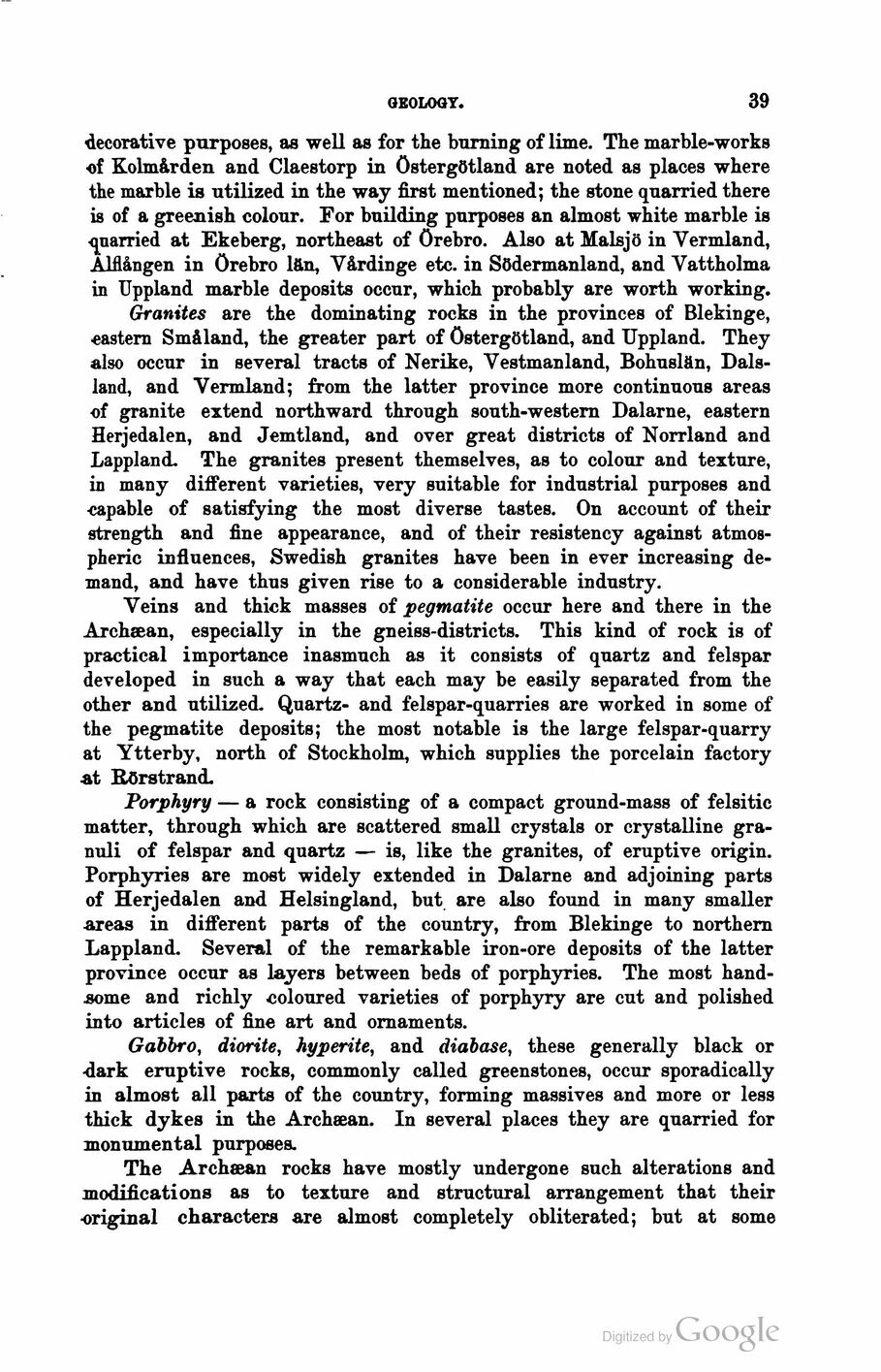
Full resolution (JPEG) - On this page / på denna sida - First part - I. Physical Geography - 3. Geology. By E. Erdmann, Ph. D., State geologist, Stockholm

<< prev. page << föreg. sida << >> nästa sida >> next page >>
Below is the raw OCR text
from the above scanned image.
Do you see an error? Proofread the page now!
Här nedan syns maskintolkade texten från faksimilbilden ovan.
Ser du något fel? Korrekturläs sidan nu!
This page has never been proofread. / Denna sida har aldrig korrekturlästs.
GEOLOGY.
39
decorative purposes, as well as for the burning of lime. The marble-works
■of Kolmården and Claestorp in Östergötland are noted as places where
the marble is utilized in the way first mentioned; the stone quarried there
is of a greenish colour. For building purposes an almost white marble is
quarried at Ekeberg, northeast of Örebro. Also at Malsjö in Vermland,
Alflången in Örebro län, Vårdinge etc. in Södermanland, and Vattholma
in Uppland marble deposits occur, which probably are worth working.
Granites are the dominating rocks in the provinces of Blekinge,
■eastern Småland, the greater part of Östergötland, and Uppland. They
also occur in several tracts of Nerike, Vestmanland, Bohuslän,
Dalsland, and Vermland; from the latter province more continuous areas
of granite extend northward through south-western Dalarne, eastern
Herjedalen, and Jemtland, and over great districts of Norrland and
Lappland. The granites present themselves, as to colour and texture,
in many different varieties, very suitable for industrial purposes and
■capable of satisfying the most diverse tastes. On account of their
strength and fine appearance, and of their resistency against
atmospheric influences, Swedish granites have been in ever increasing
demand, and have thus given rise to a considerable industry.
Veins and thick masses of pegmatite occur here and there in the
Archaean, especially in the gneiss-districts. This kind of röck is of
practical importance inasmuch as it consists of quartz and felspar
developed in such a way that each may be easily separated from the
other and utilized. Quartz- and felspar-quarries are worked in some of
the pegmatite deposits; the most notable is the large felspar-quarry
at Ytterby, north of Stockholm, which supplies the porcelain factory
at Rörstrand.
Porphyry — a röck consisting of a compact ground-mass of felsitic
matter, through which are scattered small crystals or crystalline
gra-nuli of felspar and quartz — is, like the granites, of eruptive origin.
Porphyries are most widely extended in Dalarne and adjoining parts
of Herjedalen and Helsingland, but are also found in many smaller
-areas in different parts of the country, from Blekinge to northern
Lappland. Several of the remarkable iron-ore deposits of the latter
province occur as layers between beds of porphyries. The most
handsome and richly coloured varieties of porphyry are cut and polished
into articles of fine art and ornaments.
Gabbro, diorite, hyperite, and diabase, these generally black or
dark eruptive rocks, commonly called greenstones, occur sporadically
in almost all parts of the country, forming massives and more or less
thick dykes in the Archaean. In several places they are quarried for
monumental purposes.
The Archaean rocks have mostly undergone such alterations and
modifications as to texture and structural arrangement that their
•original characters are almost completely obliterated; but at some
<< prev. page << föreg. sida << >> nästa sida >> next page >>